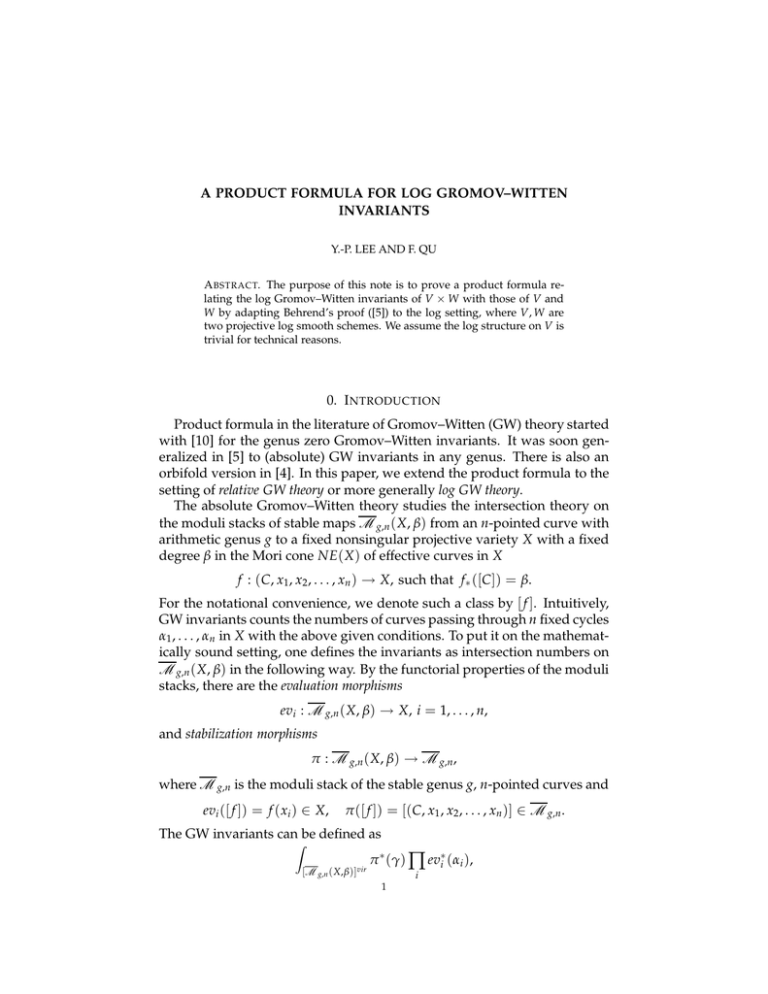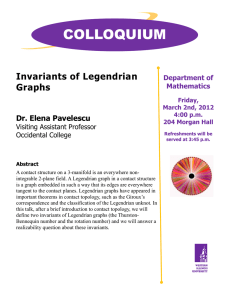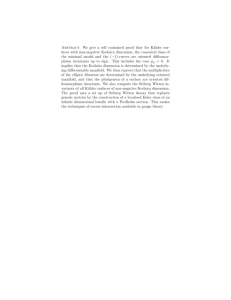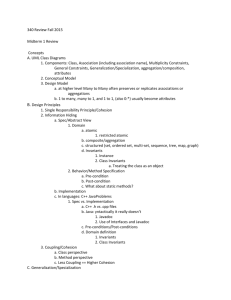A PRODUCT FORMULA FOR LOG GROMOV–WITTEN INVARIANTS ×
advertisement

A PRODUCT FORMULA FOR LOG GROMOV–WITTEN
INVARIANTS
Y.-P. LEE AND F. QU
A BSTRACT. The purpose of this note is to prove a product formula relating the log Gromov–Witten invariants of V × W with those of V and
W by adapting Behrend’s proof ([5]) to the log setting, where V, W are
two projective log smooth schemes. We assume the log structure on V is
trivial for technical reasons.
0. I NTRODUCTION
Product formula in the literature of Gromov–Witten (GW) theory started
with [10] for the genus zero Gromov–Witten invariants. It was soon generalized in [5] to (absolute) GW invariants in any genus. There is also an
orbifold version in [4]. In this paper, we extend the product formula to the
setting of relative GW theory or more generally log GW theory.
The absolute Gromov–Witten theory studies the intersection theory on
the moduli stacks of stable maps
g,n ( X, β) from an n-pointed curve with
arithmetic genus g to a fixed nonsingular projective variety X with a fixed
degree β in the Mori cone NE( X ) of effective curves in X
M
f : (C, x1 , x2 , . . . , xn ) → X, such that f ∗ ([C ]) = β.
For the notational convenience, we denote such a class by [ f ]. Intuitively,
GW invariants counts the numbers of curves passing through n fixed cycles
α1 , . . . , αn in X with the above given conditions. To put it on the mathematically sound setting, one defines the invariants as intersection numbers on
g,n ( X, β) in the following way. By the functorial properties of the moduli
stacks, there are the evaluation morphisms
M
evi :
M
g,n ( X, β)
and stabilization morphisms
where
M
π:
g,n
M
→ X, i = 1, . . . , n,
g,n ( X, β)
→
M
g,n ,
is the moduli stack of the stable genus g, n-pointed curves and
evi ([ f ]) = f ( xi ) ∈ X,
π ([ f ]) = [(C, x1 , x2 , . . . , xn )] ∈
The GW invariants can be defined as
Z
[
M
g,n ( X,β )]
vir
π ∗ (γ) ∏ ev∗i (αi ),
i
1
M
g,n .
2
Y.-P. LEE AND F. QU
M
where [ g,n ( X, β)]vir is the virtual fundamental class. One can rephrase
these invariants in terms of Gromov–Witten correspondence
∗
⊗n
RX
→ H∗(
g,n,β : H ( X )
via
Z
[
M
∗
g,n
( X,β)]vir
π (γ) ∏
i
ev∗i (αi )
=
Z
M
M
g,n )
γ.R X
g,n,β ( ∏ α i ).
g,n
i
The details can be found in [5] and references therein.
Intuitively, the relative invariants as defined in [12] and [13] can be considered as refined counting. Let ( X, D ) be a pair of nonsingular projective
variety X and a smooth divisor D in X. If the curve C does not lie in D, it
intersects with D at ρ points with multiplicities µ1 , . . . , µρ such that
∑ µ j = β.[D].
j
The refined counting is to fix the profile (µ1 , . . . , µρ ) and (possibly) restrict
the ρ points to chosen cycles {δj } in D. Similarly, one can define the relative invariants as the intersection numbers on the relative moduli stacks as
above. See [13] and [12] for details. There is also a similar reformulation in
terms of correspondences. See Section 3.
The divisor D in X gives a divisorial log structure. One can generalize
the relative invariants to the setting of log GW. See Section 1 for a brief
summary of log geometry and log GW theory.
In a sense, the study of Gromov–Witten theory is the study of the virtual
fundamental classes. The product formula is a statement that GW invariants
of V and W determine the invariants of V × W. It can be written in the form of
certain functorial properties of the virtual classes. In [5] K. Behrend proves
the product formula for the absolute GW invariants by first establishing a
corresponding functorial property of the virtual fundamental classes. In
this note, we approach the product formula in the relative and log settings in a similar way. We generally follow the framework of Behrend’s
proof, with new ingredients and necessary modifications for the log GW
theory. The main results are Theorem 2.1 and Corollary 3.1, which expresses
the log/relative invariants of V × W by invariants of V and of W. For technical
reasons, we were not able to prove the product formula in the general log
setting and we have to assume log structure on one of factors to be trivial.
We expect this current product formula is useful in the study of GW
theory. For example, it will play a role in proving the crepant transformation
conjecture for ordinary flops with non-split vector bundles in [11].
1. P RELIMINARIES
1.1. Log geometry. We refer to [9, Sections 1-4] for general background on
log structures on schemes, and [16, Section 5] for log stacks. We will need
the definition of saturated morphisms not presented there.
A PRODUCT FORMULA FOR LOG GROMOV–WITTEN INVARIANTS
3
Definition 1.1. Let P, Q be saturated monoids, a map P → Q is saturated, if it
is integral and the push out of
P −−−→ Q
y
R
is saturated when R is saturated.
Definition 1.2. Let ( X, MX ), (Y, MY ) be fine saturated (fs) log schemes, a map
f : ( X, MX ) → (Y, MY ) is called saturated, if for any x ∈ X, y = f ( x), the
induced map between characteristics MY,y → M X,x is saturated.
Remark 1.3. Given the above definition, a saturated morphism between fs
log stacks can be defined locally with respect to the lisse-étale topology as
a saturated morphism between fs log schemes.
It follows from the definition that saturated morphisms satisfy the following properties:
• They are stable under composition and base change in the category
of fs log stacks.
• For a cartesian square
(W, MW ) −−−→ ( X, MX )
fy
y
( Z, MZ ) −−−→ (Y, MY )
in the category of fs log stacks, when f is saturated,
W −−−→
y
X
y
Z −−−→ Y
is cartesian in the category of stacks.
For a fs log stack X, TorX is defined in [16, Remark 5.26]. Any log map in
the category of fs log stacks S → X factors through TorX :
S → TorX → X,
such that S → TorX is strict, and TorX → X is log étale. If X is log smooth,
TorX is pure dimensional.
1.2. Log Gromov–Witten theory. We work over the base log scheme Spec C
with the trivial log structure.
Let
g,n (resp.
g,n ) be the algebraic stack of stable (resp. prestable)
curves of genus g with n marked points. The log structure of
g,n is the
divisorial log structure associated with its boundary consisting of singular
curves. The log structure of
g,n is determined from the smooth chart
M
M
M
M
4
M
Y.-P. LEE AND F. QU
M
M
M
M
⊔m g,n+m → g,n , recall the map from g,n+m → g,n is forgetting the
extra m marked points without stabilizing. We view
g,n and
g,n as log
stacks from now on using the same notation.
Note that the forgetful map
g,n is saturated, as it can be
g,n +1 →
identified as the universal log curve. This implies the stabilization map
g,n →
g,n is saturated.
For a projective log smooth scheme V, let g,n (V ) be the fs log stack
parameterizing stable log maps from log curves of genus g with n marked
points ([1, 6, 8]). For a fs log scheme S, a log map from S to g,n (V ) corresponds to a stable log map:
M
M
M
M
M
M
M
C −−−→ V
.
y
(1)
S
M
M
We note that the underlying map of the diagram is stable.
A log map V → W induces a stabilization map g,n (V ) →
g,n (W ).
Given S → g,n (V ) which corresponds to a diagram (1), the composition
S → g,n (V ) → g,n (W ) corresponds to
M
M
M
C −−−→ W
,
y
S
where the underlying map of C → W is the stabilization of the underlying
map C → V → W, and the log structure on C is the push forward of the
log structure on C with respect to the partial stabilization C → C. See [3,
appendix B] for details.
We have a natural log map
g,n (V ) →
g,n forgetting the map to
V. It follows from (the definition in) [16] the log cotangent complex is
the cotangent complex of the induced map
g,n (V ) → TorM g,n . Using
this, a (relative) perfect obstruction theory is defined in [8, Section 5] for
→ g,n ing,n (V ) → TorM g,n . Note that a factorization
g,n (V ) →
duces a factorization g,n (V ) → TorN → TorMg,n . Furthermore, a perfect
obstruction theory for g,n (V ) → TorMg,n can be viewed as a perfect ob→ g,n is log étale.
struction theory for g,n (V ) → TorN when
M
M
M
M
M
M
M
M
N
M
N M
1.3. Virtual Pullbacks. We recall the results on virtual pullback construction in [14] to be used later. Let f : X → Y be a map of DM-type, a perfect
obstruction theory E• → L f induces an embedding of the intrinsic normal
cone C f to the vector bundle stack h1 /h0 (( E• )∨ ). It is shown in [14] that this
embedding gives rise to a bivariant class f ! in A∗ ( X → Y ), and when Y is
pure dimensional, f ! [Y ] is the virtual class of X determined by E• → L f .
A PRODUCT FORMULA FOR LOG GROMOV–WITTEN INVARIANTS
2. P RODUCT
5
FORMULA IN TERMS OF VIRTUAL CLASSES
2.1. Setup. We start by introducing relevant commutative diagrams. Denote D the stack whose point consists of n-pointed prestable curves C, C ′ , C ′′
of genus g together with partial stabilizations p′ : C → C ′ and p′′ : C → C ′′ ,
such that no component of C is contracted by both p′ , p′′ . Define e : D →
′ ′′
g,n as the forgetful morphism taking ( p , p ) to C. It is proved in [5,
Lemma 4] e is étale, and we can view D as a fs log stack by pulling back
the log structure on g,n . A log map S → D corresponds to n-pointed log
curves C, C ′ , C ′′ of genus g over S, together with log maps p′ : C → C ′ and
p′′ : C → C ′′ whose underlying maps are partial stabilizations.
We claim that the following commutative diagram is cartesian in the category of fs log stacks
M
M
M
g,n (V
(2)
g,n (V ) ×
M
−−−→
D
M
M
× W ) −−−→
y
M
g,n
y
×
M
M
g,n (W )
g,n .
M
M
Here the top horizontal arrow is determined by stabilization maps g,n (V ×
W) →
g,n (V ),
g,n (V × W ) →
g,n (W ) induced from the projections
pr1 : V × W → V, pr2 : V × W → W. Left vertical arrow is defined by
retaining the curve together with its partial stabilizations with respect to
pr1 , pr2 .
The reason for the diagram being cartesian is essentially the same as that
in [5, Proposition 5]. A commutative diagram
S −−−→
y
M
g,n (V ) ×
M
D −−−→
g,n
y
M
×
g,n (W )
M
g,n
corresponds to stable log maps C ′ → V, C ′′ → W over S, together with
stabilization between log curves C → C ′ , C → C ′′ . This recovers a stable
log map C → C ′ × C ′′ → V × W. Indeed, D is constructed to make (2)
cartesian.
We then extend the above cartesian diagram in the category of fs log
stacks to
M
h
g,n (V
× W ) −−−→
cy
−−−→
D
ey
M
g,n
l
P
y
P
y
M
g,n
−−−→
φ
−−−→
∆
−−−→
M
g,n (V )
M
M
×
ay
g,n
g,n
×
y
×
M
g,n (W )
M
M
g,n
g,n
.
6
Y.-P. LEE AND F. QU
We note that all squares are cartesian.
If V, W has trivial log structure, this reduces to Diagram (2) of [5]. In this
case it is proved in [5] that
• the relative perfect obstruction theories for a and c are compatible
([5, Proposition 6]);
• l is representable, proper, surjective, and D, P both have g,n as an
open dense substack ([5, Proposition 3]).
Using the result that virtual pullbacks are bivariant classes, it is easy to
show ([5, Theorem 1]) that
M
(3)
h∗ ([
M
× W )]vir ) = ∆! ([
g,n (V
M
g,n (V )]
vir
×[
M
g,n (W )]
vir
).
Our goal of this paper is to show that (3) holds in the case when W is
allowed to have a nontrivial log structure.
M
M
2.2. Product formula in log GW theory. When W has nontrivial log structure, the relative obstruction theory for the log map g,n (W ) → g,n is the
relative obstruction theory for the induced strict map g,n (W ) → TorMg,n .
We factor
a
a : g,n (V ) × g,n (W ) → g,n × g,n
M
into
M
g,n (V ) ×
M
M
g,n (W )
M
a′
→
M
M
M
g,n
M
× TorMg,n →
g,n
×
M
g,n .
We have the following commutative diagram in which all squares are cartesian in fs log stacks.
M
(4)
h
g,n (V
× W ) −−−→
c′ y
−−−→
D′
y
D
y
M
g,n
l′
l
−−−→
P
y
P′
y
P
y
M
g,n
−−−→
φ′
−−−→
φ
−−−→
∆
−−−→
M
g,n (V )
M
g,n
M
M
×
a′ y
M
g,n (W )
× TorMg,n
y
g,n
g,n
×
y
×
M
M
g,n
g,n .
Main Lemma.
(I) If we forget log structures, these square diagrams are also
cartesian in the category of stacks.
(II) The relative perfect obstruction theories for a′ and c′ are compatible.
(III) l ′ is proper of degree 1.
(IV) φ′ is a l.c.i. and is compatible with ∆ in the sense that the cotangent complex
L∆ pulls back to Lφ′ .
A PRODUCT FORMULA FOR LOG GROMOV–WITTEN INVARIANTS
Theorem 2.1. Using the notations in (4), we have
h∗ ([
M
g,n (V
× W )]vir ) = ∆! ([
M
g,n (V )]
vir
×[
M
g,n (W )]
7
vir
)
vir
)
in the log GW setting, assuming the trivial log structure on V.
Proof. This follows from Main Lemma.
h∗ ([
M
g,n (V
× W )]vir ) = h∗ c′! [D′ ] = a′! l∗′ [D′ ] = a′! [P′ ]
M ] × [TorM ])
= φ a ([M ] × [TorM ])
= φ ([M (V )] × [M (W )]
= ∆ ([M (V )] × [M (W )]
= a′! φ′! ([
g,n
′! ′!
g,n
g,n
′!
g,n
vir
g,n
!
vir
g,n
g,n
g,n
vir
).
˜
2.3. Proof of Main Lemma.
M
M
(I). As a′ is strict, the first row of squares are cartesian. Since g,n →
g,n
is saturated, the bottom square is cartesian.
For the second row, to prove the two squares are cartesian is the same as
showing the squares in the following diagram are cartesian in stacks.
l′
D′ −−−→
y
(5)
l
pr2 ◦ φ′
P′ −−−→ TorMg,n
y
y
M
pr2 ◦ φ
D −−−→ P −−−→
g,n .
We claim that l ◦ pr2 ◦ φ and pr2 ◦ φ are both saturated. l ◦ pr2 ◦ φ is saturated because as a log map locally it is the map between stable log curves
forgetting marked points. (See the proof of [5, proposition 3]. What we
need is that Diagram (4) there to be commutative.) pr2 ◦ φ is saturated as it
is the base change by g.n →
g,n
M
M
P
y
M
g.n
pr2 ◦ φ
−−−→
−−−→
M
g,n
y
M
g,n .
Thus, both squares in (5) are cartesian.
M
′
(II). We remark that as TorMg,n →
g,n is log étale, D is log étale over
D. Thus the relative perfect obstruction theory for the log map g,n (V ×
W ) → g,n can be viewed as the relative perfect obstruction theory for the
underlying map of c′ . Compatibility check is the same as in [5, Propsition
6].
M
M
8
Y.-P. LEE AND F. QU
(III). Start with Diagram (5). The open embedding
P −−−→
y
→ TorMg,n induces
g,n
y
pr2 ◦ φ′
D′ −−−→
y
M
pr2 ◦ φ
l
M
g,n
P′ −−−→ TorMg,n
y
y
l′
(6)
M
pr2 ◦ φ
l
D −−−→
y
M
D −−−→ P −−−→
g,n .
being log smooth, it is open and dense in TorMg,n . Note that both
pr2 ◦ φ, l ◦ pr2 ◦ φ are flat surjective, we conclude D(resp. P) are open dense
substacks of D′ (resp. P′ ).
g,n
(IV). We factor
M
g,n
M
g,n
× TorMg,n →
M
× TorMg,n →
M
g,n
g,n
× TorMg,n →
×
M
M
g,n
g,n
into
× TorM g,n →
M
g,n
×
M
g,n .
First arrow is saturated and flat, and second arrow strict and smooth. Note
that
TorM g,n −−−→
g,n × TorM g,n
y
y
M
M
∆
g,n
−−−→
M
g,n
×
M
g,n
is cartesian in fs log stack as well as in stacks, and horizontal arrows are
compatible l.c.i. maps.
2.4. Remarks on the case V with general log structure. When V has nontrivial log structure, we will need to factor a by
M
g,n (V )
×
M
g,n (W )
→ TorMg,n × TorMg,n .
As the underlying stack of the fiber product of
M
∆
g,n
−−−→
TorM g,n × TorM g,n
y
M
g,n
×
M
g,n
is no longer a fiber product in the category of stacks, (I) is likely false, and
proofs for (III), (IV) above break down, though (II) holds as before. However, if it is true that g,n (V ) → g,n is saturated, we can replace TorMg,n
by its open substack parameterizing saturated maps and (I), (III), (IV) go
through without any problem.
M
M
A PRODUCT FORMULA FOR LOG GROMOV–WITTEN INVARIANTS
3. A PPLICATIONS
TO RELATIVE
G ROMOV–W ITTEN
9
INVARIANTS
We apply this to the relative GW invariants as defined by A. Li and Y. Ruan
[12], and J. Li [13]. (A different definition by Ionel and Parker is not used
here.)
Let X and Y be nonsingular projective varieties , and D a a smooth divisor in Y. We further assume H 1 (Y ) = 0, so a curve class of X × Y is
determined by its projection in X and Y. Therefore, a curve class of X × Y
is of the form ( β 1 , β 2 ) where β 1 (resp. β 2 ) is a curve class of X (resp. Y).
Let ΓY = ( g, n, β 2 , ρ, µ) encodes the discrete invariants:
R g for the genus,
β2 the curve class, µ = (µ1 , ...µρ ) an ordered partition of β D. Let ΓY (Y, D )
be the relative moduli stack. We have evaluation maps
M
evY :
M
ΓY (Y, D )
and the stabilization maps
π:
→ Yn,
M
evD :
ΓY (Y, D )
→
M
M
ΓY (Y, D )
→ Dρ
g,n + ρ .
Relative GW invariants can be viewed as the Gromov–Witten transformations
R Γ Y : H ∗ (Y ) ⊗ n ⊗ H ∗ ( D ) ⊗ ρ → H ∗ (
defined as
PD π∗ evY∗ (α)ev∗D (δ) ∩ [
M
M
g,n + ρ )
ΓY (Y, D )]
vir
where PD stands for the Poincaré duality.
Let Γ X ×Y = ( g, n, ( β 1 , β2 ), ρ, µ). Similarly we have
R Γ X ×Y : H ∗ ( X × Y ) ⊗ n ⊗ H ∗ ( X × D ) ⊗ ρ → H ∗ (
Let Γ X = ( g, n + ρ, β 1 ). The map
RΓ X : H ∗ ( X )⊗(n+ρ) → H ∗ (
is the Gromov–Witten correspondence
M
M
,
g,n + ρ ).
g,n + ρ )
RX
g,n + ρ,β 1 .
Corollary 3.1.
RΓ X×Y ((α1 ⊗ α1′ ) ⊗ ... ⊗ ((αn ⊗ α′n )); (αn+1 ⊗ δ1 ) ⊗ ... ⊗ ((αn+ρ ⊗ δρ ))
= RΓ X (α1 ⊗ ... ⊗ αn+ρ ) RΓY (α1′ ⊗ ... ⊗ α′n ; δ1 ⊗ ... ⊗ δρ ),
where αi ∈ H ∗ ( X ), α′i ∈ H ∗ (Y ) and δj ∈ H ∗ ( D ).
Proof. This follows from Theorem 2.1 and the comparison result between
relative and log GW invariants in [3, Theorem 1.1, section 2.3].
˜
R EFERENCES
[1] D. Abramovich, Q. Chen, Stable Logarithmic maps to Deligne-Faltings pairs II, arXiv:
1102.4531v2.
[2] D. Abramovich,Q. Chen,W. Gillam, S. Marcus, The evaluation space of logarithmic stable
maps, arXiv: 1012.5416v1.
[3] D. Abramovich, S. Marcus, J. Wise, Comparison theorems for Gromov-Witten invariants of
smooth pairs and of degenerations arXiv: 1207.2085v1.
10
Y.-P. LEE AND F. QU
[4] E. Andreini, Y. Jiang, H.-H. Tseng, Gromov-Witten theory of product stacks, arXiv:
0905.2258v1.
[5] K. Behrend, The product formula for Gromov-Witten Invariants, J. Algebraic Geom. 8
(1999), no.3, 529-541.
[6] Q. Chen, Stable Logarithmic maps to Deligne-Faltings pairs I, arXiv: 1008.3090v4.
[7] W. D. Gillam, Logarithmic stacks and minimality, arXiv: 1103.2140v1.
[8] M. Gross, B. Siebert, Logarithmic Gromov-Witten invariants, arXiv: 1102.4322v1.
[9] K. Kato, Logarithmic structures of Fontaine-Illusie, in Algebraic analysis, geometry, and
number theory, Johns Hopkins Univ. Press (1989) pp.191-224.
[10] M. Kontsevich, Yu. Manin, Quantum cohomology of a product. With an appendix by R.
Kaufmann. Invent. Math. 124 (1996), no. 1-3, 313-339.
[11] Y.-P. Lee, H.-W. Lin, F. Qu, C.-L. Wang, In preparation.
[12] A. Li and Y. Ruan, Symplectic surgery and Gromov-Witten invariants of Calabi-Yau 3-folds,
Invent. Math. 145 (2001), no. 1, 151-218.
[13] J. Li, Stable morphisms to singular schemes and relative stable morphisms, J. Differential
Geom. 57 (2001), no. 3, 509-578.
[14] C. Manolache, Virtual pull-backs, J. Algebraic Geom. 21 (2012), no.2, 201-245.
[15] M. C. Olsson, The logarithmic cotangent complex, Math. Ann. 333 (2005), no.4, 859–931.
[16] M. C. Olsson, Logarithmic geometry and algebraic stacks, Ann. Sci. École Norm. Sup. (4)
36 (2003), no. 5, 747-791.
E-mail address: yplee@math.utah.edu
E-mail address: qu@math.utah.edu




